Want better results from your Facebook ads? Do you understand how the Facebook ads delivery system works?
In this article, you'll learn how the learning phase of Facebook ads affects your ads' visibility and find tools to improve ad performance.
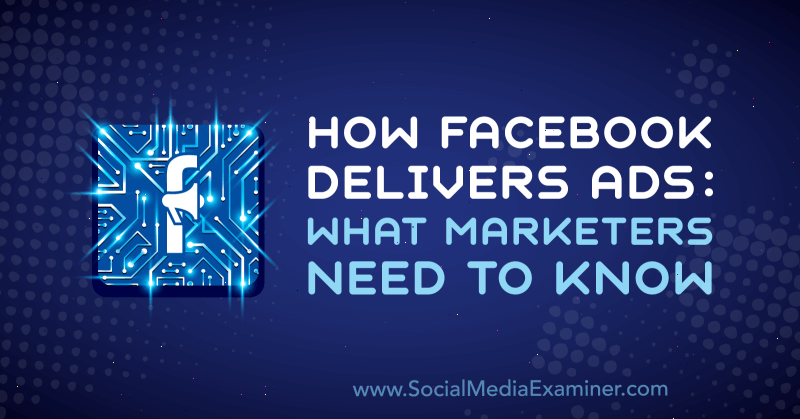
How Does the Facebook Ads Delivery System Work?
The Facebook auction and algorithm were designed to keep users engaged and show them the best, most relevant ads.
Facebook's algorithm is one of the most powerful algorithms in the world, and it's designed to show engaging, likeable posts. The algorithm creates more factors that contribute to how high your ad is placed in the news feed; it's not just about your bid and budget.
The Facebook algorithm and auction are the systems that decide the placement of Facebook ads. So what's the difference between the two? The algorithm creates a system that determines when and where each Facebook ad gets placed, whereas the auction decides which ad from which advertiser will get displayed to which user.
Facebook advertisers are competing for the top of the news feed in the auction. Ads are rated in the auction based on the engagement, audience, and bid. This means that to get the highest visibility, you need amazing engagement (comments, shares, reactions), a well-defined audience, and the right bid to reach that audience.
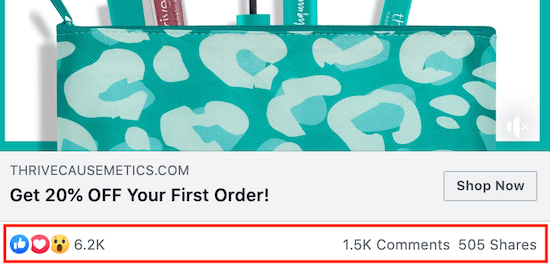
How does Facebook determine how well your ads will perform with the algorithm and in the auction? With the learning phase.
The Learning Phase of Facebook Ads Delivery
The learning phase is the period of time the algorithm needs to learn how to deliver your Facebook ads as efficiently as possible. Every time new ads enter the auction, they enter the learning phase so the algorithm can decide which ad gets delivered where and to which user.
The algorithm learns from a series of patterns, and patterns are easier to determine with time and trial and error. The more times Facebook shows your ads (impressions), the better the algorithm becomes at discovering these patterns, resulting in a lower cost per action (CPA) and better overall performance.
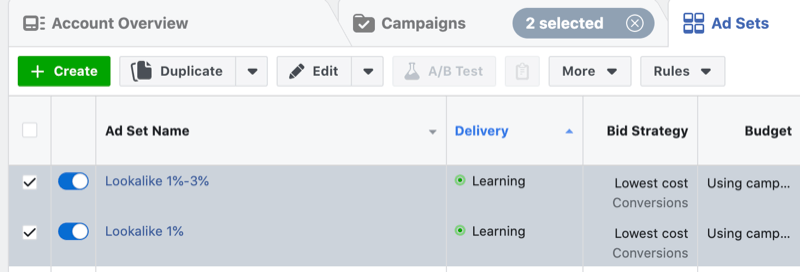
Your Facebook ads will exit the learning phase when you reach around 50 events for the objective you've optimized for (Purchases or Add to Cart, for example).
Once your ad set hits 50 conversions, your ad will start delivering in active mode, which is the most stable phase of your ads. This is the phase where your costs should be the most consistent and your conversions should be generating at a normal pace.
Get World-Class Marketing Training — All Year Long!
Are you facing doubt, uncertainty, or overwhelm? The Social Media Marketing Society can help.
Each month, you’ll receive training from trusted marketing experts, covering everything from AI to organic social marketing. When you join, you’ll also get immediate access to:
- A library of 100+ marketing trainings
- A community of like-minded marketers
- Monthly online community meetups
- Relevant news and trends updates

If your ad set doesn't generate 50 conversions, it will kick into learning limited phase. Depending on your product and business goals, learning limited is something you'll either look to as a red flag or learn to ignore.
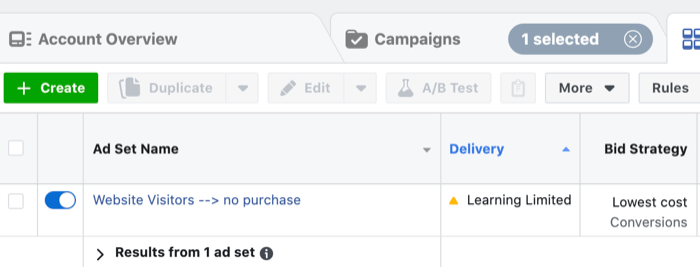
Three key performance indicators can help you determine whether learning limited is something you should work to get out of or ignore:
- What's your CPA to profit-margin costs? If your cost per purchase is relatively high and your profit margin is low, you won't see a high return on ad spend (ROAS). In this case, you should use the tips in section #2 below to get your ads out of learning limited.
- Check your ROAS. Facebook calculates your profitability for you. If your ROAS is low, you'll want to get your ads out of learning limited.
- Identify the break-even point for your business and Facebook ads. Every business has its own break-even point with ads. If your business has a low average order value (AOV) and high expenses, your break-even point could be higher. Basically, if you aren't getting the sales you need to be profitable, you'll want to avoid learning limited.
Read on for step-by-step instructions on analyzing the learning phase and eliminating learning limited.
#1: Identify How Your Facebook Ads Are Delivering
You can identify which delivery phase your Facebook ads are in—active, learning, or learning limited—by looking at the Delivery column in Facebook Ads Manager.
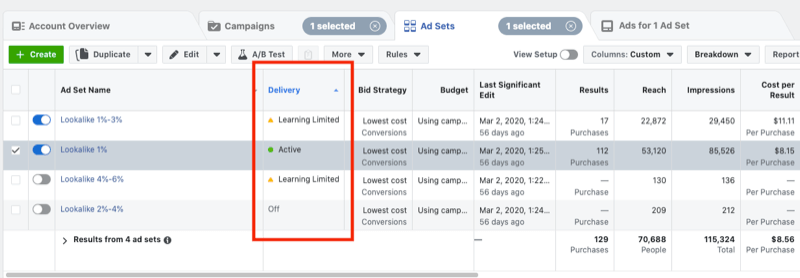
When you're planning your campaigns, keep in mind that Facebook ads perform best (in most cases) when they've exited the learning phase. So if you're planning a holiday sale, know that your campaign needs time to learn before it will perform at its best and you can gauge success.
In addition to giving your campaign this time, make sure your sale lasts long enough to collect data when your campaign is out of the learning phase. Or you can accelerate the learning phase by fueling the engine with more money.
Pro Tip: Remember, all new Facebook ads will enter the learning phase. Because the algorithm is still learning what works best for your ads and audience, it's best not to make changes until your campaign has exited the learning phase and entered the active or learning limited phase.
#2: Keep Your Facebook Ads From Reverting to the Learning Phase
Once your Facebook ads are displayed in active mode or the learning phase, your CPAs should drop (more on how to determine this later). When your ads start performing optimally and have exited the learning phase, you should take steps to avoid re-entering the learning phase.
Follow these guidelines to keep your Facebook campaigns from crashing back into the learning phase:
- Make budget changes slowly. Increasing your budget by 10%–20% won't kick your ads back into the learning phase so it's advisable to slowly increase your budget. You can make a 10% budget increase each day, but for larger changes, either duplicate your campaign or be aware that your campaign will go back into the learning phase. The learning phase is not the end of the world but it does mean your ads aren't stabilized and producing optimal results.
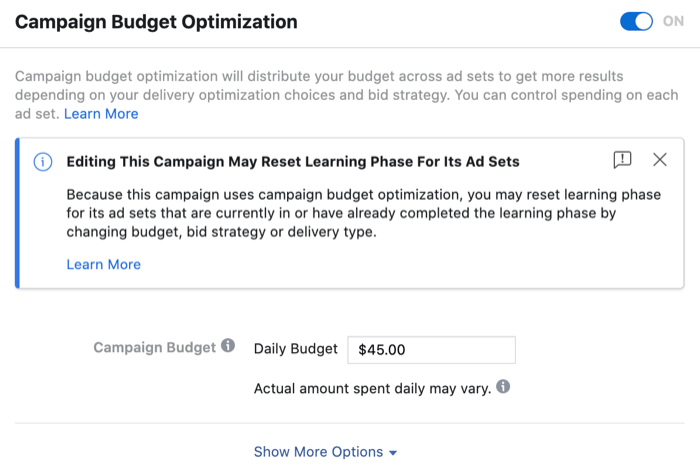

Discover Proven Marketing Strategies and Tips
Want to go even deeper with your marketing? Check out the Social Media Marketing Podcast! Publishing weekly since 2012, the Social Media Marketing Podcast helps you navigate the constantly changing marketing jungle, with expert interviews from marketing pros.
But don’t let the name fool you. This show is about a lot more than just social media marketing. With over 600 episodes and millions of downloads each year, this show has been a trusted source for marketers for well over a decade.
- Avoid making changes to your bid control or ROAS control amount. If your CPAs are high and you want to improve this by switching your bid control strategy, know that it will kick your campaign back into the learning phase.
- If you want to make changes to your creative and update your text or images, batch your changes. Make your changes all at once and wait a week between changes so the algorithm can re-learn and maximize results. Even changing a comma or a word in your text can kick your ads back into learning. This is another reason to make sure your creative is edited and tested before your campaign goes live.
#3: Troubleshoot Facebook Ads in the Learning Limited Phase of Delivery
If the Delivery column displays Learning Limited and your CPA, ROAS, and break-even point all tell you that you should aim to get into the active phase, follow these steps to troubleshoot and get out of learning limited:
- Combine Facebook ad sets, ads, and campaigns. Too many options make it hard for the algorithm to learn what works best for your audience. On the same note, too many audiences and creatives will spread your budget thin, which hinders the algorithm from finding the right people to convert. One way to combine audiences is to look at your audience overlap.
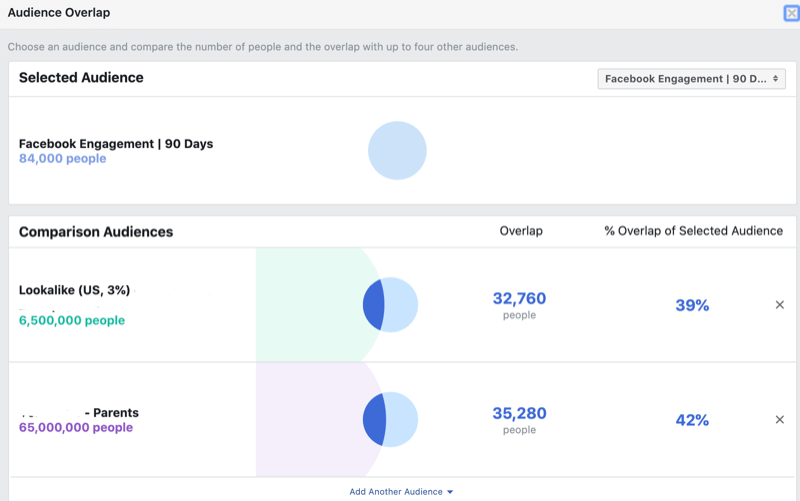
- Broaden your audience. If you selected a niched audience for your ad set, try expanding your audience. This will give Facebook more options so it can generate 50 conversions and hopefully move your campaign into active mode.
- Try increasing your budget. Increasing your budget will give Facebook the opportunity to get more impressions, which means more data and more ways for Facebook to get 50 conversions to get out of the learning phase.
- Increase or decrease your bid or cost control. The same way increasing your budget can get your campaign 50 conversions, so can increasing or decreasing your bid and cost control. Bids and control caps help your Facebook ads get rated in the auction so it's important to find your bid cap sweet spot—where you can control your CPAs but still generate enough leads to avoid learning limited.
- If your cost per result is too high, optimize for something higher in your funnel. Instead of optimizing for purchases, try optimizing for Add to Cart. The goal is to hit 50 events in a 7-day period.
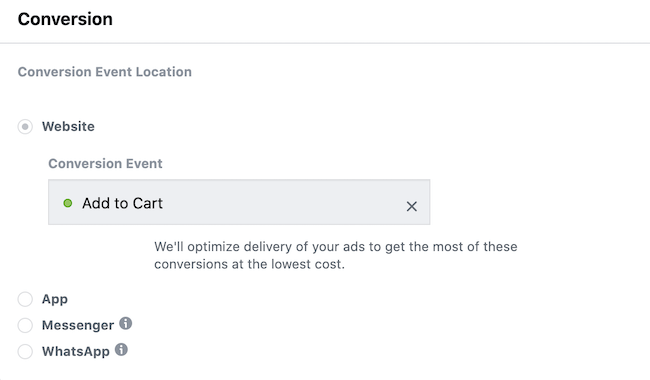
Of course, all of these changes will kick your Facebook ads back into the learning phase but they'll also give your ad set the opportunity to go into active mode next, instead of learning limited. The learning phase works in a running 7-day window so keep this in mind as your timeline. If you're still stuck in learning limited but your ads are out of the learning phase, you can analyze more data with the Inspect tool, described next.
#4: Analyze Facebook Ad Performance With the Inspect Tool
Once your Facebook ad set has more than 3 days of data, you can use the Inspect tool to see how your ad set is performing with several different metrics and visual graphs. You can use this tool even if your ad set is in the learning phase.
Unfortunately, the Inspect tool is only available for certain campaign objectives. Currently, these objectives are Traffic, App Installs, Lead Generation, and Conversions.
To use the Inspect tool, first enter the Facebook campaign you want to analyze. Then click under the name of the ad set you want to inspect. Or click Edit and then the magnifying glass icon.
Now you're in the Inspect tool.
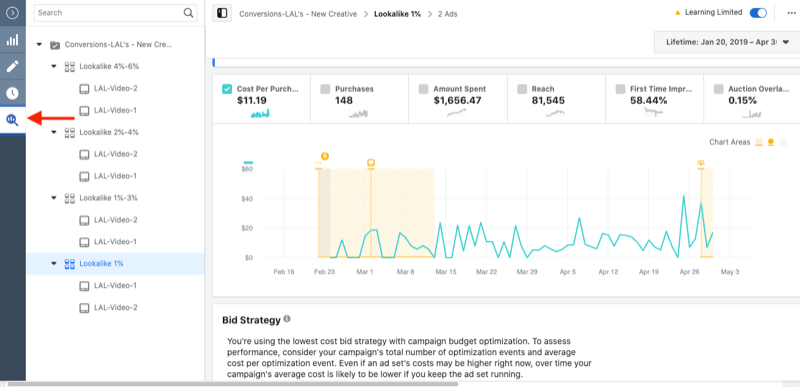
The Inspect tool shows auction competition details. The more competition your Facebook ad account has, the higher your CPAs will be.
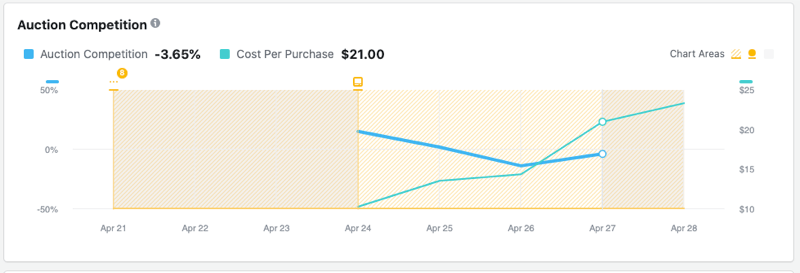
The Inspect tool also shows how the learning phase has impacted your Facebook ads. You can determine whether your ads are profitable in the learning phase and see if prices increased or decreased.
You can also see the First-Time Impression Ratio, which is the percentage of daily impressions that comes from people seeing your ads for the first time. This is crucial if you're looking to get more new prospects into the top of your funnel.
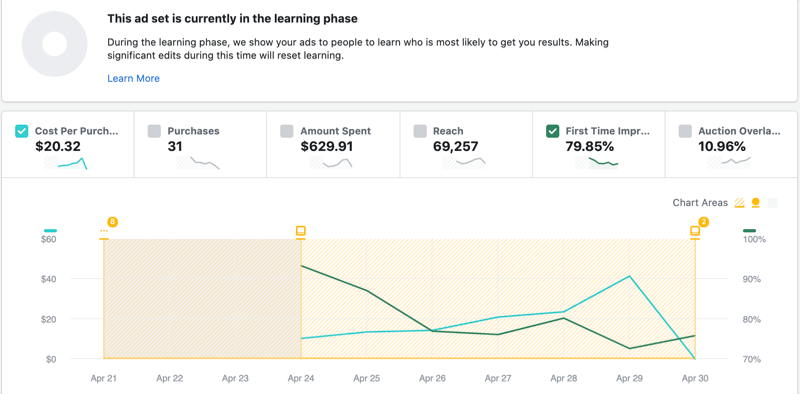
Auction Overlap is the number of times an ad set was removed from the auction because it competed with one of your other ad sets. If your campaigns have a low reach or number of impressions, review this data to see if you need to combine some audiences and ad sets.
The Inspect tool also shows your significant edit history, which will help you understand how your edits affect Facebook ad performance and the learning phase.
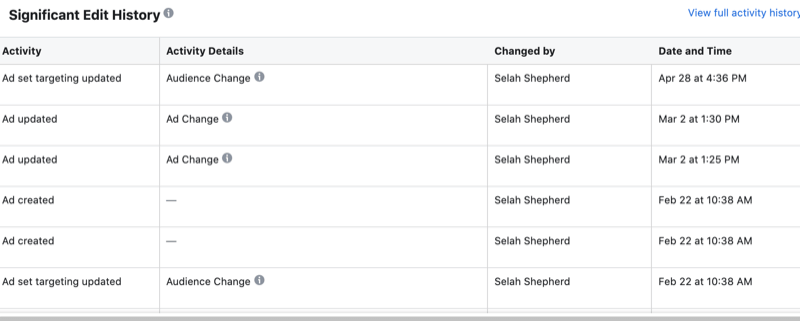
Some Facebook advertisers discover their ads perform best in the learning phase so they always make changes and updates to their ads to keep them in that phase. The Inspect tool gives you the data you need to make informed decisions about how your ads deliver so you can do what's best for your business.
Conclusion
With more than 7 million global advertisers, it's important to analyze your Facebook ad performance in the beginning phases so you can optimize and scale your campaign for success.
The next time you launch a Facebook campaign, analyze your account in the learning, learning limited, and active phases so you can harness Facebook's algorithm. If you can create profitable campaigns in the learning phase, you can analyze how your campaign performs in different phases and then scale the right campaigns at the right time.
If the algorithm works with your ads, not against them, your business will be more profitable with Facebook ads.
What do you think? How do you use the learning phase to gauge the success of your Facebook campaigns? Share your thoughts in the comments below.
More articles on Facebook ads:
- Explore eight costly Facebook ad mistakes and how to avoid them.
- Discover three custom reports in Ads Manager to help you quickly analyze your Facebook ad performance.
- Find out how to choose the right placements to deliver the best results for your Facebook campaign.
Attention Agency Owners, Brand Marketers, and Consultants

Introducing the Marketing Agency Show–our newest podcast designed to explore the struggles of agency marketers.
Join show host and agency owner, Brooke Sellas, as she interviews agency marketers and digs deep into their biggest challenges. Explore topics like navigating rough economic times, leveraging AI, service diversification, client acquisition, and much more.
Just pull up your favorite podcast app, search for Marketing Agency Show and start listening. Or click the button below for more information.

